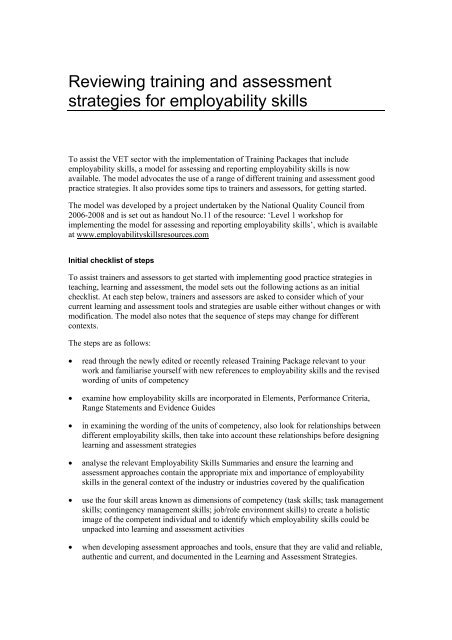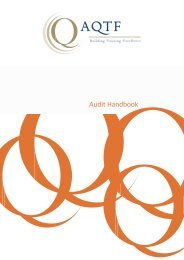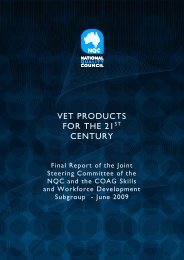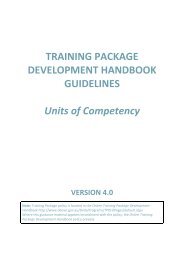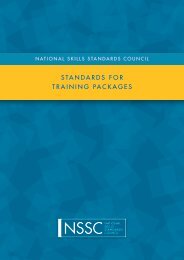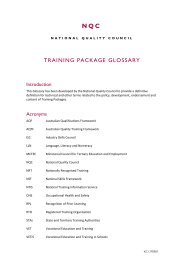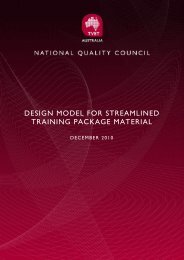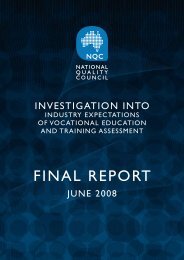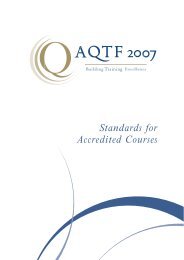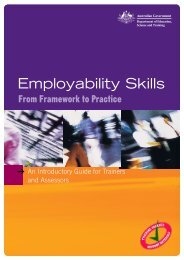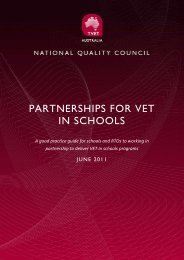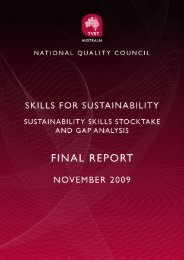Reviewing training and assessment strategies for employability skills
Reviewing training and assessment strategies for employability skills
Reviewing training and assessment strategies for employability skills
You also want an ePaper? Increase the reach of your titles
YUMPU automatically turns print PDFs into web optimized ePapers that Google loves.
<strong>Reviewing</strong> <strong>training</strong> <strong>and</strong> <strong>assessment</strong><strong>strategies</strong> <strong>for</strong> <strong>employability</strong> <strong>skills</strong>To assist the VET sector with the implementation of Training Packages that include<strong>employability</strong> <strong>skills</strong>, a model <strong>for</strong> assessing <strong>and</strong> reporting <strong>employability</strong> <strong>skills</strong> is nowavailable. The model advocates the use of a range of different <strong>training</strong> <strong>and</strong> <strong>assessment</strong> goodpractice <strong>strategies</strong>. It also provides some tips to trainers <strong>and</strong> assessors, <strong>for</strong> getting started.The model was developed by a project undertaken by the National Quality Council from2006-2008 <strong>and</strong> is set out as h<strong>and</strong>out No.11 of the resource: ‘Level 1 workshop <strong>for</strong>implementing the model <strong>for</strong> assessing <strong>and</strong> reporting <strong>employability</strong> <strong>skills</strong>’, which is availableat www.<strong>employability</strong><strong>skills</strong>resources.comInitial checklist of stepsTo assist trainers <strong>and</strong> assessors to get started with implementing good practice <strong>strategies</strong> inteaching, learning <strong>and</strong> <strong>assessment</strong>, the model sets out the following actions as an initialchecklist. At each step below, trainers <strong>and</strong> assessors are asked to consider which of yourcurrent learning <strong>and</strong> <strong>assessment</strong> tools <strong>and</strong> <strong>strategies</strong> are usable either without changes or withmodification. The model also notes that the sequence of steps may change <strong>for</strong> differentcontexts.The steps are as follows:• read through the newly edited or recently released Training Package relevant to yourwork <strong>and</strong> familiarise yourself with new references to <strong>employability</strong> <strong>skills</strong> <strong>and</strong> the revisedwording of units of competency• examine how <strong>employability</strong> <strong>skills</strong> are incorporated in Elements, Per<strong>for</strong>mance Criteria,Range Statements <strong>and</strong> Evidence Guides• in examining the wording of the units of competency, also look <strong>for</strong> relationships betweendifferent <strong>employability</strong> <strong>skills</strong>, then take into account these relationships be<strong>for</strong>e designinglearning <strong>and</strong> <strong>assessment</strong> <strong>strategies</strong>• analyse the relevant Employability Skills Summaries <strong>and</strong> ensure the learning <strong>and</strong><strong>assessment</strong> approaches contain the appropriate mix <strong>and</strong> importance of <strong>employability</strong><strong>skills</strong> in the general context of the industry or industries covered by the qualification• use the four skill areas known as dimensions of competency (task <strong>skills</strong>; task management<strong>skills</strong>; contingency management <strong>skills</strong>; job/role environment <strong>skills</strong>) to create a holisticimage of the competent individual <strong>and</strong> to identify which <strong>employability</strong> <strong>skills</strong> could beunpacked into learning <strong>and</strong> <strong>assessment</strong> activities• when developing <strong>assessment</strong> approaches <strong>and</strong> tools, ensure that they are valid <strong>and</strong> reliable,authentic <strong>and</strong> current, <strong>and</strong> documented in the Learning <strong>and</strong> Assessment Strategies.
Ten tips <strong>for</strong> trainersThe good practice steps set out above are the product of interviews, focus groups <strong>and</strong> otherconsultations, but these steps were not designed to be the last word on the topic of goodpractice in relation to <strong>employability</strong> <strong>skills</strong>. An RTO that has investigated <strong>employability</strong> <strong>skills</strong>thoroughly <strong>and</strong> developed checklists <strong>and</strong> tools is the University of Ballarat. Over the period2003-2006, <strong>and</strong> funded in part by Reframing the Future, a project team at the Universityfocused on <strong>employability</strong> <strong>skills</strong>, <strong>and</strong> produced a range of booklets, templates <strong>and</strong> guides thatare publicly available at the following site:http://www.ballarat.edu.au/vfed/learning_<strong>and</strong>_teaching/educational_projects/2006/<strong>employability</strong>_<strong>skills</strong>/<strong>employability</strong>_<strong>skills</strong>_2006.shtml#ResourcesIrene Warfe, a teacher in the Department of Humanities <strong>and</strong> Further Education, University ofBallarat, played a lead role in the project <strong>and</strong> reports that one of the very useful checklists toresult from the project is called “Ten Tips <strong>for</strong> Developing Employability Skills”.The ten tips from the University of Ballarat <strong>for</strong> trainers are:• use action learning <strong>strategies</strong> that link the learner to the ‘real work’ including problembasedlearning• apply learning methods that increase the explicitness of <strong>employability</strong> <strong>skills</strong>, such asincluding case studies that highlight <strong>employability</strong> <strong>skills</strong>• develop a range of learning <strong>strategies</strong> to engage learners, such as drawing connectionsbetween <strong>employability</strong> <strong>skills</strong> <strong>and</strong> learners’ interests <strong>and</strong> life experiences• help learners reflect on their own learning, <strong>for</strong> instance by using checklists of<strong>employability</strong> <strong>skills</strong> to assist learners to think about the <strong>skills</strong> they have developed• use group work thoughtfully to help learners develop the <strong>skills</strong> to work in a team• use the learning program to foster self-directed learning, <strong>for</strong> example by providingopportunities <strong>for</strong> learners to negotiate <strong>assessment</strong> activities• build relationships of respect <strong>and</strong> trust with your learners• give regular feedback on the learners’ development of <strong>employability</strong> <strong>skills</strong>• continue to develop your own <strong>skills</strong>• ‘be the change that you want to see in the world’ (M. G<strong>and</strong>hi).Other providers could develop their own checklists of good practice, using the University ofBallarat list as a cue or starting point.Revising existing tools <strong>and</strong> resourcesAnother <strong>training</strong> provider that has examined good practice regarding the <strong>assessment</strong> of<strong>employability</strong> <strong>skills</strong> is First Impressions Resources, a retail <strong>training</strong> specialist RTO which hasits headquarters in Brisbane.
First Impressions’ Assessment Co-ordinatorGwen Moroney reports how her company isreviewing processes <strong>and</strong> practices in relationto the Retail Services Training Package(SIR07) following the embedding of<strong>employability</strong> <strong>skills</strong>:“Embedding has meant that <strong>employability</strong><strong>skills</strong> are not treated separately from thecompetencies within the Training Packageunits,” says Moroney, “but are appropriatelyinterwoven with the unit <strong>skills</strong> <strong>and</strong> knowledgeoutcomes”.As a result, says Moroney, there are no separate <strong>assessment</strong> tools or student resourcematerials <strong>for</strong> <strong>employability</strong> <strong>skills</strong> – “the existing resources are being progressively revised toseamlessly incorporate them”.Professional development within First Impressions has included encouraging trainers <strong>and</strong>assessors to look more holistically at job roles:Through professional development, trainers <strong>and</strong> assessors have been encouraged to see theembedding of <strong>employability</strong> <strong>skills</strong> as an enhancement of what they have already been doing; as away of looking more holistically at job roles <strong>and</strong> skill-sets <strong>and</strong> as a part of continuousimprovement.The initial work at First Impressions has included the following actions:• identifying which specific <strong>employability</strong> <strong>skills</strong> are present in each unit of competency inthe Training Package• focusing on the facets of the relevant <strong>employability</strong> <strong>skills</strong> at the appropriate AQF level toidentify the outcomes required• revising <strong>training</strong> materials <strong>and</strong> <strong>assessment</strong> tools to accurately include the appropriate<strong>employability</strong> <strong>skills</strong> <strong>and</strong> facets.• providing professional development opportunities to trainers <strong>and</strong> assessors so theyunderst<strong>and</strong> the value <strong>and</strong> importance of <strong>employability</strong> <strong>skills</strong>, are able to identify them at aunit level, <strong>and</strong> can seamlessly include them in their <strong>training</strong> delivery <strong>and</strong> <strong>assessment</strong>evidence collection.Validating existing <strong>assessment</strong> practicesFor some <strong>training</strong> providers, the inclusion of<strong>employability</strong> <strong>skills</strong> within Training Packages hasvalidated their previous approaches to on-the-job<strong>assessment</strong>.This is the view of Chris Butler (pictured),Accreditation Manager, People <strong>and</strong> Culture,Australian Shared Services, Insurance Australia Group(IAG):As an Enterprise RTO, now that <strong>employability</strong> <strong>skills</strong> are embedded in per<strong>for</strong>mance criteria <strong>and</strong>other aspects of Training Packages, we believe our <strong>assessment</strong> <strong>strategies</strong> - which are completed
on the job in real time - are validated.Butler believes that “the incorporation of <strong>employability</strong> <strong>skills</strong> strengthens the competencyst<strong>and</strong>ards”:This is the opinion of IAG RTO, where the new st<strong>and</strong>ards remove the previous ambiguity ofensuring learning <strong>and</strong> <strong>assessment</strong>s cover the per<strong>for</strong>mance criteria <strong>and</strong> key competencies.Butler also believes that the inclusion of <strong>employability</strong> <strong>skills</strong> in Training Packages “allowsthe VET practitioner a clearer picture of what a competent person looks like when collectingevidence”.<strong>Reviewing</strong> <strong>strategies</strong>To assist the VET sector with the implementation of Training Packages that include<strong>employability</strong> <strong>skills</strong>, the model <strong>for</strong> assessing <strong>and</strong> reporting <strong>employability</strong> <strong>skills</strong> advocates theuse of a range of different good practice <strong>strategies</strong>. These <strong>strategies</strong> are generic ones <strong>and</strong>ultimately each <strong>training</strong> provider needs to refine the generic <strong>strategies</strong> <strong>and</strong> develop their own.Training organisations such as the University of Ballarat, First Impressions Resources <strong>and</strong>IAG are reviewing their existing <strong>strategies</strong> in a range of ways that suit their context, includingtheir learners <strong>and</strong> workplaces. In each case the <strong>training</strong> provider is developing good practiceprinciples <strong>and</strong> practices to ensure the quality of <strong>training</strong> <strong>and</strong> <strong>assessment</strong>.This work has been produced on behalf of the National Quality Council with funding providedthrough the Australian Government Department of Education Employment <strong>and</strong> WorkplaceRelations <strong>and</strong> state <strong>and</strong> territory governments. Disclaimer: the views expressed herein arenot necessarily those of the Australian Government or state <strong>and</strong> territory governments.


